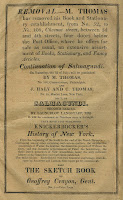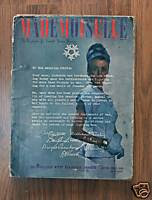
Elizabeth Palmer Peabody is another of the grossly underappreciated women in American History. I came to know her by her connections with American magazines (how else?).

Ms. Peabody was one of the founders of the American transcendentalist movement and is best remembered for her role in pioneering juvenile education. A brief biographical essay follows:
http://www.alcott.net/alcott/home/champions/Peabody.htmlWhen my son Tyson, now 34 and the father of my two grandaughters, was in high school, he told me how impressed he was after reading Henry David Thoreau's monumental essay on civil disobedience "Resistance to Civil Government".
http://www.transcendentalists.com/civil_disobedience.htmThis immediately brought to mind to this incurable collector, the question of where it was first published. To my delight I found it was first delivered as an essay in 1847 and first published in an exceedingly rare magazine,
Aesthetic Papers, in 1849. Hence my introduction to the venerable Ms. Peabody who edited the journal.
Of course, the next mission was to obtain a copy. In the days before the internet, finding books was no easy task. I found a copy in an old catalog of M & S Books (Dan Siegel) of Providence, Rhode Island priced at $4500 (a pretty hefty bite in the 1980's when the dollar was worth fifty cents as opposed to today's value of a quarter!). I called Dan and it had been sold.
I then made it known to every major American bookdealer that I'd like to obtain one. No copy showed up for a number of years. Then, one year in the early 90's my customary annual trip to the Boston Book Fair was delayed by a severe snowstorm, causing me to arrive about one hour after the opening. The first dealer I ran into, Rob Roulon of Roulon Miller Books, figuratively punched me in the stomach when he told me that a copy of
Aesthetic Papers in original wrappers had been sold to a collector just a few minutes earlier for $1000! As you can imagine, I was not a happy camper.
A few years later I was able to find to the one illustrated above, an ex-lib copy for $1250 (still a pretty good deal). I haven't had a sniff of another one since.
If you read my last blog, I bemoaned the fact that I don't own a copy of the November 18, 1865 issue
Saturday Press, that contains the first printing of Twain's "Jumping Frog of Calaveras County". I should also note that two weeks earlier, this obscure magazine first published another blockbuster, Walt Whitman's "Oh Captain, My Caption".
Here we go again! I called Rich West at Periodyssey and he has never held any issue of this magazine. Another holy grail to search for. What the hey, that's what a collector lives for anyhow.
Speaking of transcendendalism, no comprehensive American magazine collection can ignore this important era in our history, which also encompasses the literature of the many utopian communities that flourished at the time. I have quite a few representative magazines but the acknowleged best is
The Dial, with contributions by Margaret Fuller (another forgotten female genious) Thoreau and Emerson, to mention only a few. I was able to get a complete bound run from the great Michael Ginsberg and recently obtained another issue in original wrappers from Rich (he may have one or two more- worth owning, 4135271900, I don't get a commission!).

To those who observe, the best of the Easter/Passover season. See you again shortly!



















